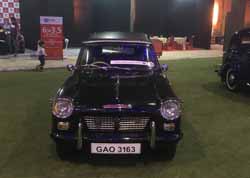Standard Herald 1962

Badged in the Indian market as the Standard Herald, the Herald was originally heavily dependent on British parts, but as these were gradually replaced by indigenous items specifications and trim as local content increased. By 1965 engines, gearboxes, and axles were all made in India. In 1966 the Standard Herald Mark II was introduced, which featured the bonnet and front end of the Vitesse, but strangely with the outer pair of headlights blocked off and the parking lights cum side-indicators incorporated there instead. In anticipation of the Mark III, very late Mk IIs featured modified rear bodywork (different roofline and a bootlid without a recess)
The new Standard Herald Mark III, made from 1968 to 1971, received a unique indigenously developed four-door body,to meet the demands of Indian buyers (with large families) and competition from the Ambassador and Fiat 1100 (both of which featured four doors). The engine remained the same though, with a claimed top speed of 109–112 km/h (68–70 mph). In 1969-1970 a very few Herald Mark III Companions were built, five-door estates with fibreglass roofs and tailgates. The "Companion" nameplate hearkens back to the Standard Ten-based Companion introduced in 1955.
The Standard Herald was first manufactured in 1962 by Standard Motor co. in Madras. It had different body styles of 2 or 4 door with a soft or hard top. It was originally a Triumph Herald from England. It had a very good engine for those days and was direct competition to the Ambassador and the Fiat 1100. It was used a lot on the race tracks in Madras and Calcutta for its quick pick up and my father who worked for a British co. used to race it for the directors against other cars. It used to clock around 105kmph and was an overhead valve engine.
I bought my 1962 soft top coupe Standard Herald in 2001 in a very dilapidated condition and it took me 1 1/2 years to restore it to a road worthy condition. It was presented to my elder daughter on her 18th birthday in March 2003 and was originally painted a lemon yellow colour which was very eye catching. Due to a lot of rusting, I again had to do a lot of body work and this time she was painted a British racing green colour.
Neville Ginwala